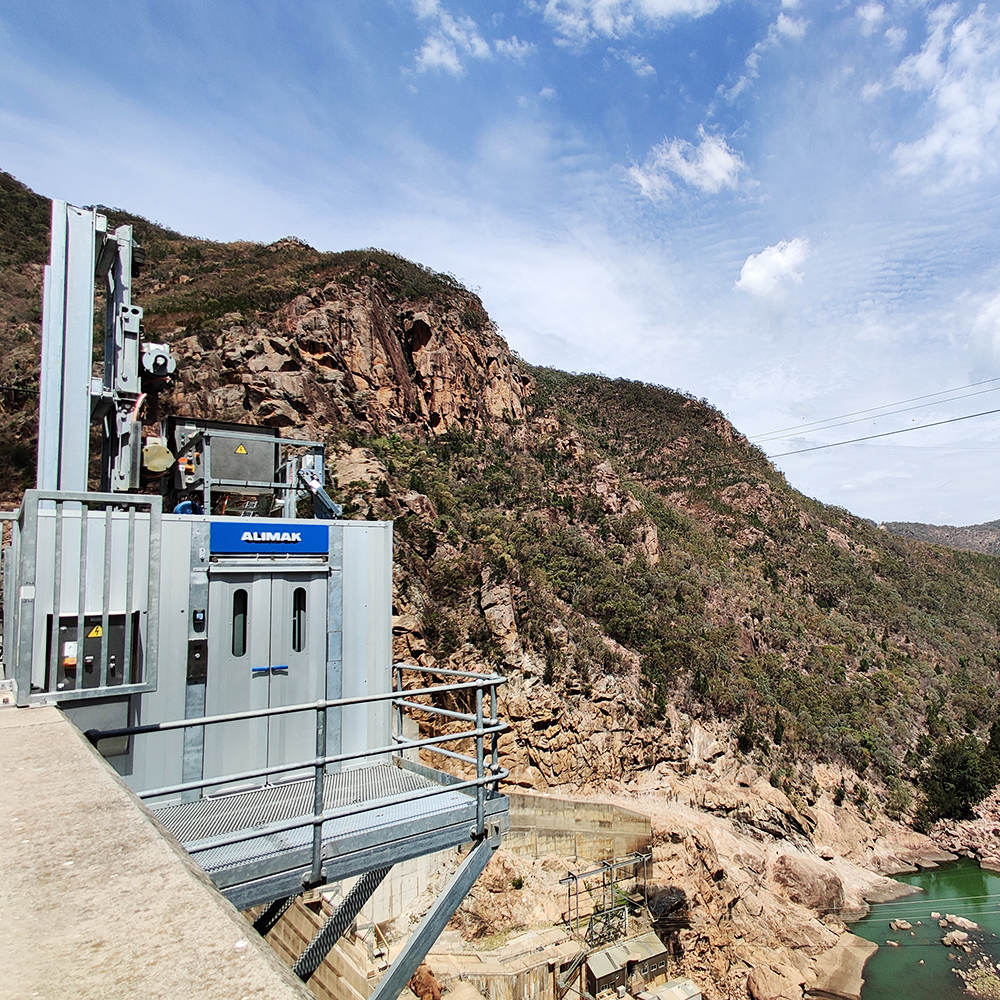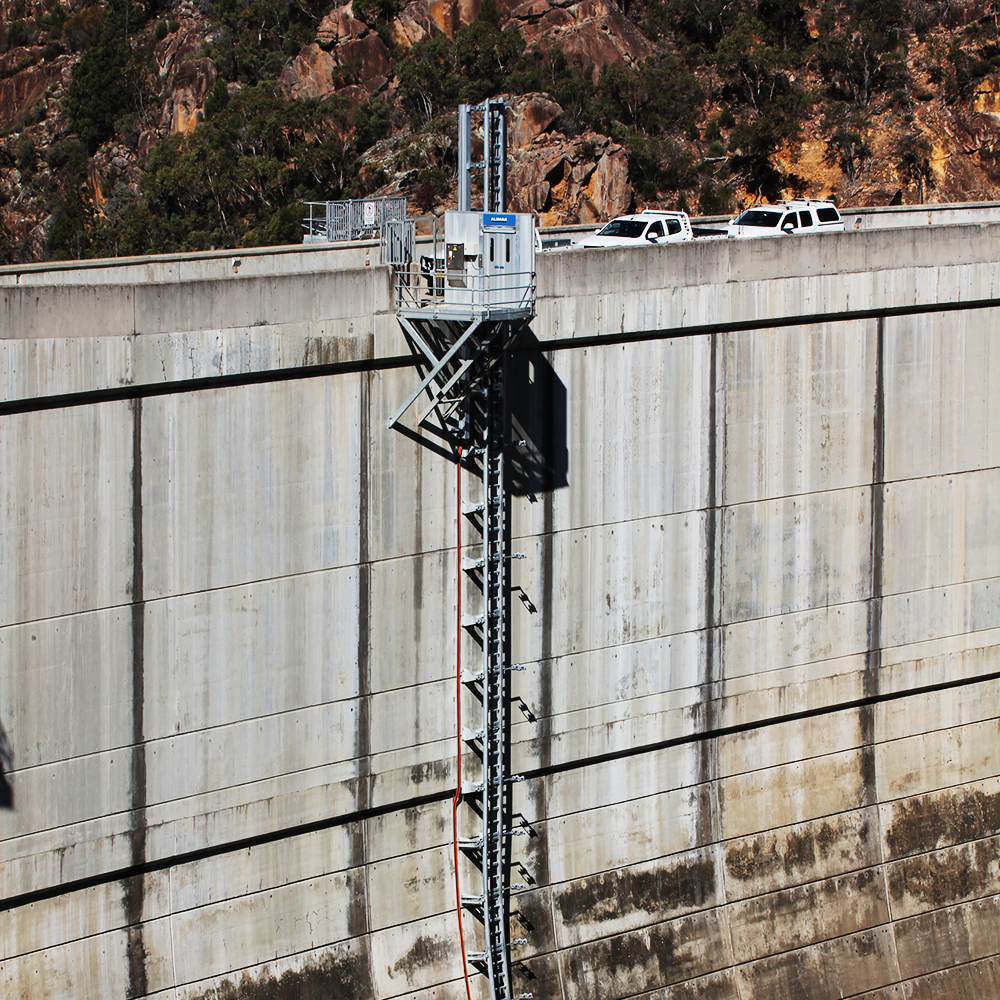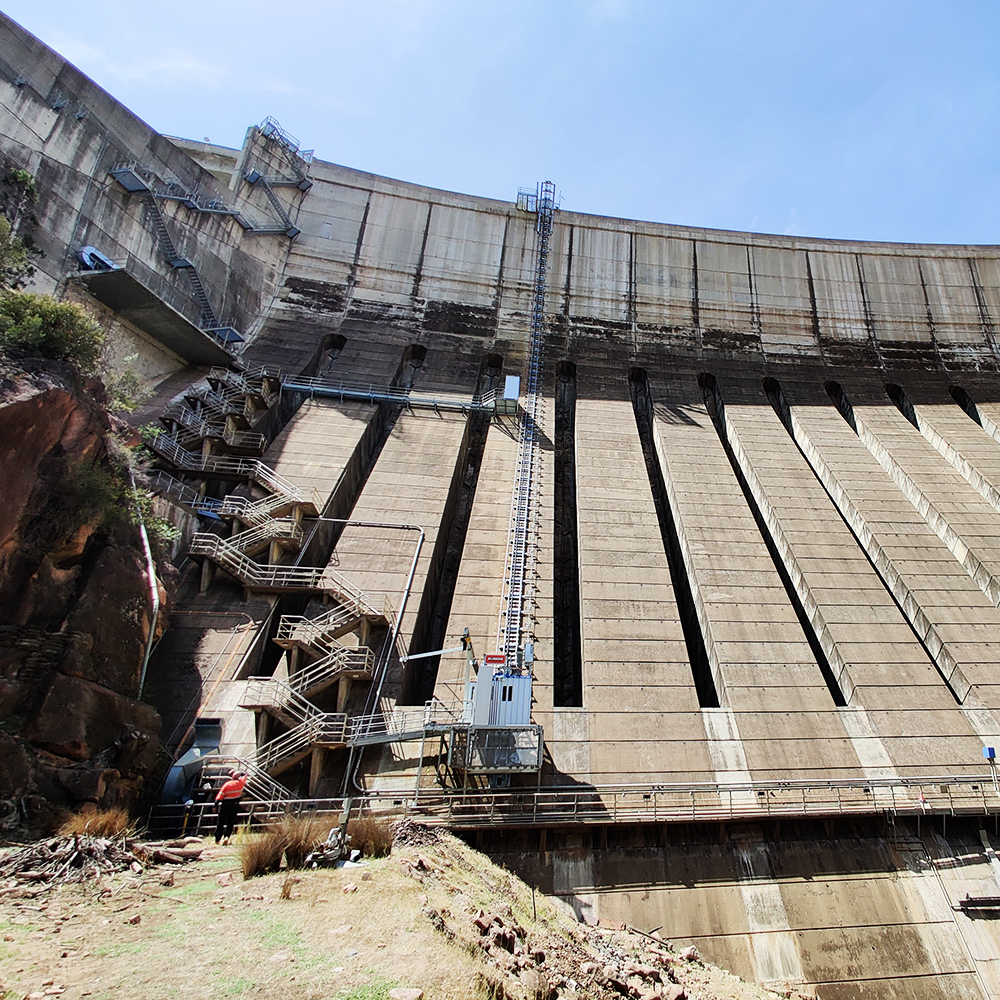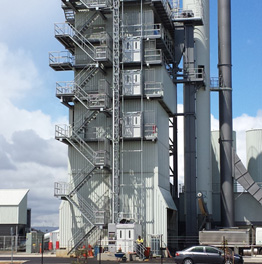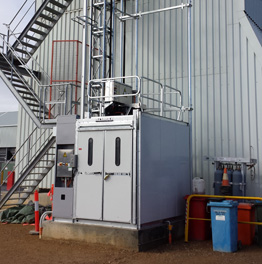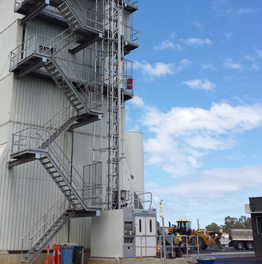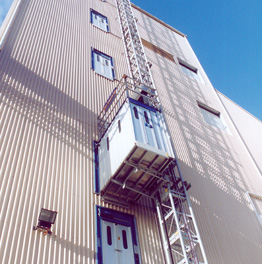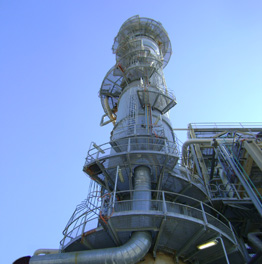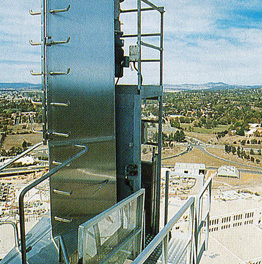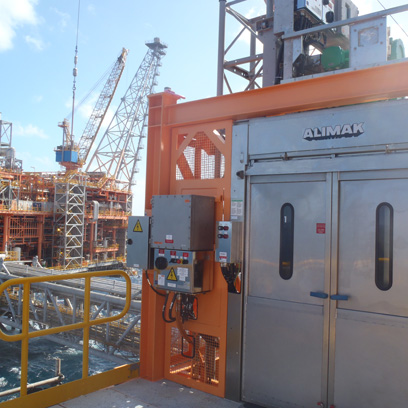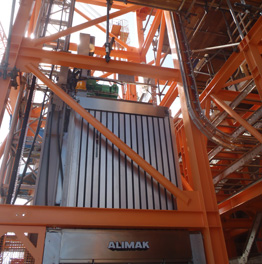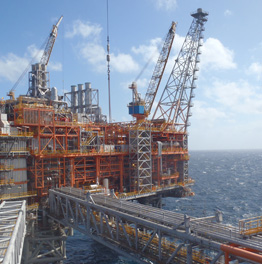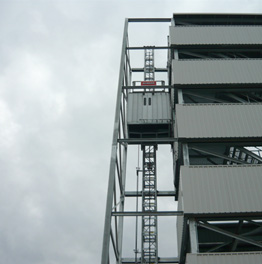The Central Deborah Gold Mine, a key historical site in Bendigo, Australia, has long been a testament to the region’s rich mining heritage. Operating from 1939 to 1954, the mine extracted 929 kg of gold—worth approximately $150 million AUD today. At its peak, the mine reached a depth of 412 meters, encompassing 17 levels and 15 kilometers of tunnels. Today, it operates as a tourist gold mine, showcasing Bendigo’s underground gold rush story.
Since 1986, the site has had an Alimak™ Scando™ 20/32 TD elevator that has been transporting visitors 61 metres underground to experience the harsh realities of Australia’s gold rush era. With over 60,000 visitors annually, the elevator plays a critical role in ensuring safe, reliable access to the mine’s historic depths.
In 2022, the Alimak Scando 20/32 TD underwent a refurbishment included a fully galvanised cage, new guide rollers, rack, and upgraded electrical systems — all designed to meet modern safety standards while preserving the rugged, authentic ride that defines the visitor experience. These upgrades ensure that every journey underground is not only memorable but also secure.
But safety at Central Deborah goes beyond tourism. Deep underground, groundwater pumps at Level 4 (109 meters) remove over 1.5 million liters of contaminated water daily to protect the mine and the surrounding water table which is connected by over 5,500 historic mine shafts in the area. Until recently, maintenance crews had to climb over 100 meters of vertical ladders to reach these pumps — a physically demanding, time consuming and high-risk task.
Working within a narrow 1.2 x 1.2 metre shaft lined with timber sleepers, our team engineered a custom 300 kg, 4-passenger Alimak SE elevator with a U-600 mast — designed to fit the space without compromising the mine’s historical integrity.
To secure the elevator safely in this confined and sensitive environment:
- 36 custom rock-bolted ties were designed and installed to anchor the mast securely.
- A suspended steel pit structure was constructed at the 109-meter mark to provide a stable base.
- Timbers were carefully removed every 3.3 meters to allow for safe rock bolting, preserving the shaft’s heritage while ensuring structural integrity.
These measures eliminated the need for ladder access, significantly reducing the risk of falls, fatigue, and injury for maintenance personnel.
To avoid the high cost and complexity of crane hire — and to further enhance safety — Alimak introduced a permanent Tirak™ winch system with man-riding capabilities. This system now serves as both a materials hoist and an emergency recovery device, ensuring that workers have a safe and reliable means of evacuation in the event of an incident.
The Tirak system features a winch with a capacity of 1,000 kg, fully certified for man-riding operations. A header beam is installed above all compartments, allowing for flexible access throughout the shaft. This permanent solution offers a cost-effective alternative to temporary lifting methods, enhancing overall safety and reducing operational expenses at the site.
A Partnership Built on Trust
We are proud to support the team at Bendigo Heritage in their mission to preserve history while prioritizing safety. This project is a testament to what’s possible when engineering meets purpose — and when protecting people is the top priority.
“Our partnership with Alimak is built on trust. It is easy to have trust when Alimak continues to deliver the best products for our complex environments which are delivered by a team of caring, passionate and professional individuals who constantly go above and beyond.”
“From project initiation through to completion, the team displayed exceptional professionalism, technical knowledge, and a collaborative spirit that greatly contributed to the successful outcome of this significant heritage infrastructure upgrade. Their responsiveness to site challenges, commitment to safety, and proactive communication ensured a smooth and efficient installation process.”
James Reade, Chief Executive Officer, Bendigo Heritage
ELEVATOR DETAILS
Location: Central Deborah Mine, Victoria, Australia
Application: Tourist attraction
Industry: Mining / Tourism
Elevator models: Alimak SE 300 & Alimak Scando 20/32 TD
Capacity: 300 kg and 2,000 kg
Elevator car size: 0.78 x 0.91 m & 1.5 x 3.2 m
Speed: 0.59 & 0.65 m/s
Lifting height: 109 & 75 m
No. of landings: 4 & 2
Alimak replace a temporary construction hoist with a permanent SE 2000 industrial rack and pinion elevator on the Queensland Nickel Group’s Palmer Nickel and Cobalt Refinery. Installed in 2012, the industrial elevator was engineered to fit a pre-existing shaft within the structure.
Processing the world’s nickel
The Queensland Nickel Group’s (QNI) Palmer Nickel and Cobalt Refinery, located outside of Townsville, QLD, processes an estimated 3.8 million tonnes of nickel laterite and nickelcobalt hydroxide annually. Since its opening in the 1970s, the refinery has become one of the largest nickel processing facilities in the world, manufacturing more than 30,000 tonnes of nickel and 2,000 tonnes of cobalt each year. For over a decade, an Alimak counterweight hoist has provided personnel with access to the Palmer Refinery’s roaster building during busy shut-down periods. In 2012, this temporary hoist was replaced with a permanent Alimak SE 2000 industrial elevator, installed within a pre-existing shaft of the building.
Solving shutdown access issues
Constructed in the early 1970s, the refinery’s 13-floor roaster building is used in the reduction roasting of nickel ore. In the mid 2000’s, a temporary Alimak 28/42 counterweight hoist was installed on the roaster building’s exterior. Servicing nine floors of the structure, the Alimak hoist was used during shutdown periods on the refinery, with two traction elevators providing transportation of personnel throughout the facility.
Engineering an industrial elevator to fit
Working closely to Queensland Nickel’s specifications, Alimak designed, manufactured and installed an SE 2000 rack and pinion elevator to operate within an existing shaft inside the roaster building. A major challenge was ensuring the selected SE 2000 elevator would fit within the pre-designed shaft area; a task that involved careful designing, engineering and several modifications to the shaft. The installation of landing door assemblies proved challenging, with confined space requiring several door assemblies to be installed behind low-hanging beams.
Installation through the rooftop
Given the enclosed space of the shaft, the SE elevator’s installation required the use of a crane to manually lower the mast and elevator car into the shaft from the building’s roof. The structure’s rooftop was re-constructed to enclose the elevator shaft. These weather-proof conditions allowed the elevator-car to be completed with the standard aluminum and galvanized finish, with no additional protective surface treatment required.
Making materials transport easy
While the original Alimak counterweight hoist was fitted to the structure’s exterior and provided access to 9 levels, the new Alimak SE 2000 was installed within an internal elevator shaft and serviced all 13-levels of the roaster building, including the roof. Available for use 24 hours a day, the SE elevator transports materials, equipment and personnel, with a speciallydesigned access platform allowing for the easy loading and offloading of palletized loads. The new Alimak SE 2000 elevator has been in operation at the Palmer Nickel and Cobalt Refinery since June 2012, providing personnel and materials with safe and easy access to the roaster facility’s 13 landings. An ongoing quarterly service contract with Alimak guarantees the elevator is maintained as per the original equipment manufacturer specifications, minimizing machine downtime and extending the life of the elevator.
ELEVATOR DETAILS
Location: Palmer Nickel & Cobalt Refinery, Townsville, QLD, Australia
Industry: Metal and Steel
Application: Nickel refinery, men and material access
Elevator type: Rack and Pinion
Elevator model: Alimak SE 2000
Capacity: 2,000 kg
Elevator car size: 1.56 m x 2.21 m
Speed: 0.6 m/s
No. of landings: 13
Lifting height: 37 m
In 2004, three Alimak rack and pinion elevators of stainless steel were installed to provide access for maintenance and services at the Comalco Aluminia Refinery in Australia.
During construction of the Comalco Alumina Refinery (CAR) project in Australia, Comalco relied on three Alimak rack and pinion elevators operated in construction site ‘hoists’ style mode of operation, which allowed contractors to meet critical completion schedules, before reverting to industrial access operations as the process lines were handed over for commissioning.
Construction of Australia’s first Greenfields refinery to be built in the past decade in Australia is currently moving from a commissioning to operations phase; with three Alimak industrial elevators reverting from essential construction site duties conveying materials and labour to conventional permanent lifting duties providing access for maintenance and services.
The three Alimak elevators — two SE 1600 FC and an SE 2400 FC — operating in a construction site mode allowed the contractors of the Comalco Refinery, located in Gladstone, Queensland 530 km north of Brisbane to meet critical completion dates, finishing on-schedule.
A spokesman for the CAR project main engineering, procurement and construction contractor Bechtel Australia Pty Ltd stated that the Alimak industrial elevators were specified for their record of reliability, performance and ease of installation with the elimination of constructing a permanent elevator shaft; relying instead on proven rack and pinion techniques.
The first phase of the Comalco Alumina Refinery has been designed to produce 1.4 million tonnes of alumina per year which can be incrementally expanded in later phases to produce more than 4 mtpa. Construction of phase 1, at an estimated cost of US $750 million, started in 2002.
Biggest in Queensland
Installation of the largest of the three Alimak elevators on the alumina calcinations building was completed in March 2004. Forming part of the Theiss Goldings Joint Venture contract, the installation proved the most challenging. Needed urgently by Theiss Goldings to undertake con-struction mode lifting duties, meant constant critical installation schedules being met.
Initially installed at the fourth floor level as a construction elevator carrying people and materials, it was extended floor by floor as building progressed to the seventh floor with a final lifting height of 44 m.
The Alimak elevator was purposely positioned to sit between two ‘lobster back’ process units as a ‘tailor made’ installation including an area of limited space, allowing vehicle access past the plant and easy reversing and unloading into the elevator area. Since its installation at the end of March, the elevator has ‘clocked’ 920 hours operation in six months. Travellingat 0.6 m/sec this equates to almost 1600 km (1000 miles).
Featuring a 2,400 kg capacity and car dimensions of 2,210 mm x 1,560 mm, the high payload capacity elevator is one of two SE 2400 FC’s to be installed in Australia — the first being at Comalco’s bauxite mine in Weipa, Northern Territories. Throughout Australia more than 100 permanent Alimak elevators have been installed.
Precipitation tanks
The first of the three Alimak elevators was installed in July 2003 providing specialist USA steel tank contractor Chicago Bridge & Iron (CBI) with construction style ‘hoist’ duties for the projects precipitation tanks. Featuring a final elevator height of 30.5 m, the SE 1600 FC has today reverted to industrial elevator duties over the four floors. It provides access to the tanks and the adjacent hydrate washing processes.
Contract 330 – John Holland
Sub-contractor, John Holland has also relied on a second Alimak SE 1600 FC during construction of the plants 4-storey high liquor filtration process line in contract 330. With a travel distance of 22 m, the elevator was installed. Both SE 1600 FC elevators installed on the Comalco site feature a 1600 kg capacity and a travel speed of 0.8 m/s.
On-site power supply
With an on-site power supply rating of 690 V, the Alimak installation team had to install transformers to each elevator assembly to step-down the voltage to 420 V operation at 50 Hz.
All three elevators were specified by Comalco as stainless steel cars together with all landing doors. The masts for contracts 330 and 490 feature a galvanised finish with the unit for contract 420 painted to meet a higher specification. The Alimak elevators all feature ‘frequency controlled’ operation ensuring ‘soft start’ and ‘soft stop’ providing maximum comfort.
Boilerhouse
Contractors are also relying on an Alimak Scando 20/32 construction hoist with a 2000 kg capacity and a 3.2 m long car for lifting duties on the boilerhouse.
A 45 m high structure, the hoist ensures every maintenance and service access to various levels of the boilerhouse. A replacement to an industrial Alimak elevator is anticipated in the near future. The units 3.2 m extended length is a local health and safety requirement to allow a stretcher in the unlikely event of an emergency.
Alimak elevators
The range of Alimak industrial elevators feature a modular build with up to 30 different car sizes, measuring 0.78 m x 1.04 m — 1.56 m x 3 m and travel speeds of up to 1 m/sec. Lifting heights in excess of 250 m can be obtained using the rack and pinion techniques able to lift capacities of between 300 kg — 2,400 kg.
A recent report in the USA quoted that the cost of stairs-related falls annually within the States is estimated to be in the region of US$ 15 billion. Clearly the use of industrial-style permanent elevators can eliminate many of the accidents.
A spokesman for the CAR project stated that the Alimak industrial elevators were specified for their record of reliability, performance and ease of installation with the elimination of constructing a permanent elevator shaft; relying instead on proven rack and pinion techniques.
Alimak platforms post-tension duties
Following construction by Bechtel of two 40 m high concrete final product storage silos, four Alimak platforms were used to allow access for post-tensioning of the reinforcement bars. The platforms were positioned on four buttresses around the perimeter of each 40 m diameter silo. Throughout construction of the refinery, contractors also used three additional Alimak Scando rental hoists.
Comalco
Alumina produced from the first stage of CAR will be shipped to Comalco’s smelters in Tasmania and New Zealand. The company has also signed a long term supply agreement with the Norwegian company Hydro Aluminium to supply 300,000 t of alumina in 2005 and 500,000 t a year from 2006-2030. This represents one of the biggest alumina agreements ever signed. Comalco is a wholly owned subsidiary of Rio Tinto and is a major supplier of bauxite, alumina and aluminium products for the world markets.
ELEVATOR DETAILS
Location: Comalco Alumina Refinery, Gladstone, Australia
Industry: Metal and Steel
Application: Aluminia Refinery
Elevator type: Rack and Pinion
Elevator model: Alimak SE 1600 FC & 2400 FC
No. of elevators: 3
Capacity: 1,600 kg & 2,400 kg
Lifting height: Varies between 22 m – 44 m
Alimak works closely with Downer EDI to complete the dismantle of a 34-year old elevator, and the installation of a new Alimak elevator at Mt Isa Mines. With a lifting height of 252m, the Alimak industrial elevator provides critical maintenance access to the lead smelter chimney stack.
ACCESSING THE CHIMNEY STACK
Glencore Xstrata’s Mt Isa Mines is one of the largest mining operations in Australia, with a silver-lead-zinc stream producing more than 30,000 tonnes of zinc concentrate, 170,000 tonnes of crude lead and 230 tonnes of silver lead in bullion each year.
Built in 1978, the mine’s lead smelter chimney stack stands at 270m tall, making it Australia’s largest self-supported structure. An Electruck Easiriser elevator was originally installed within the chimney shaft, providing access to the six levels of the chimney stack for inspection and maintenance of the structure’s aircraft beacons. After 34 years of use, the Electruck elevator was decommissioned in 2012 and replaced with a new Alimak SE 700 industrial elevator.
DISMANTLE, REMOVAL AND INSTALLATION
Completion of the project occurred in two stages: the first being the removal of the original Electruck elevator and the second involving the installation and commissioning of the new Alimak SE 700.
At the customer’s recommendation, Downer completed the dismantling and removal of the Electruck elevator. During dismantle, the elevator car was used as a work platform, allowing the Downer crew to drive the elevator car to the required height, dismantle 6m sections of the mast and then lower these through the elevator car to the ground below using a floor-mounted winch system.
Once removal of the Electruck was complete, Alimak technicians began installation of the new Alimak SE 700 industrial elevator. Installation occurred in much the same way as the Electruck dismantle, with 9m lengths of the new mast winched up through the new Alimak SE elevator car. Alimak technicians used the roof of the new elevator car as a work platform from which to fix each of the new mast sections to the chimney’s existing tie supports.
Given the limited space within the chimney stack, the Alimak elevator was the ideal solution, as it could be configured to fit the existing space with only minor modifications. With a lifting height of 252m, accessing 5 landing levels, the new Alimak SE was a faster and more reliable alternative to the aging Electruck elevator. Travelling at a speed of 1.0m/s, the Alimak elevator will make the 252m journey to the top of the chimney stack in under 4.5 minutes, while the original Electruck elevator required almost 7 minutes.
ACCESS FOR CRITICAL MAINTENANCE AND INSPECTIONS
Due to the height of the chimney stack, the structure is fitted with essential air-craft warning lights that require weekly inspections and periodic changes. With the majority of the beacons located on the roof of the chimney stack, technicians are able to travel 252m to the top landing in the Alimak elevator. From there, an external ladder provides access to the roof lighting systems. Without the Alimak elevator, personnel would be required to climb an internal ladder system, which would be both time consuming and dangerous.
ALIMAK ON CHIMNEY STACKS
Alimak have completed numerous installations on chimney stacks around Australia, including Callide Power Station (220m), Kogan Creek Power Station (160m), Tarong Power Station (210m) and Loy Yang Power Station (260m). Alimak’s rack and pinion industrial elevators are the ideal access solution for power plant structures, reducing the risk of falls from height, eliminating exertion from climbing and providing easy access for inspections, emission monitoring and maintenance.
ELEVATOR DETAILS
Location: Mt Isa Mines, Queensland, Australia
Application: Chimney stack
Elevator type: Rack and pinion
Elevator model: Alimak SE 700
Capacity: 700 kg
Lifting height: 252 m
The currently constructed One Sydney Harbour in Sydney comprises of three residential towers which is adjacent to the recently opened Crown Casino. Two of the current buildings being constructed are 259 metres lifting height with 74 floors and 238 metres lifting height with 62 floors, including additional basement levels. With limited space on site, several vertical access challenges were presented and could not be solved with standard construction hoists and components.
Due to Alimak being a global company, it drew its strength off collaborating with overseas markets to utilise other systems not currently present in the local Australian market. With limited space on site and the need to provide a vertical access solution, the Common Tower was introduced.
Boundaries in CBD areas can pose issues while constructing high rise apartments. As the building increases in height, it requires more labour and materials, which in turn, there is a requirement for additional hoists. It is critical that the number of machines available on site are supplied to increase productivity. Two (2) common towers with a total of eight (8) hoists are provided to fulfil this requirement.
The purpose of a common tower is to allow the hoists to be tied to the temporary common tower structure as opposed to the building. As the high-rise building is being constructed, so too does the levels of common tower and hoists. Since the common tower takes up less face of the building, it has great advantage by allowing additional hoists on site and less impact on the façade program install which both increase the site productivity. Another benefit is to install services such as plumbing within the tower and therefore creating more space in high traffic areas reducing potential hazards on site.
High speed hoists, designed to carry 3,100 kg at 80 m/min provided increased speeds to cover the height of the building. This was a key consideration to implement on the project as it improved the efficiency of transporting both men and materials. A jump form hoist with special engineered ties connected to the external core wall is also installed, which can allow access to the jump form.
The complexity of the One Sydney Harbour project required skilled project management, high level of engineering detail and reliable machinery. This is the standard Alimak continually provide.
Alimak’s robust and reliable rack and pinion elevators are relied upon in a wide variety of tough industrial environments. Our long history includes over 50 years of experience in the provision of high quality vertical access solutions for the power industry.
A particularly complex customised industrial elevator system was required for the challenging geography of the WaterNSW Burrinjuck dam wall. The lift provides safe access to the dam outlet works for WaterNSW maintenance purposes and also services the Meridian Energy hydro power station. The heritage listed hydro electric dam which is North West of Canberra, Australia was completed in 1928. Efficient and reliable transportation between the top of the dam wall and the power station itself at the base is a vital requirement.
This was complicated, however, by the inclined, curving surface of the dam wall. With Alimak’s earlier experience in similar projects, Alimak designed a specialised industrial elevator system which is capable of securely travelling through the curved section at an angle of 53 degrees – no problem for Alimak engineers to solve. The vertical travel distance is 68 metres and, including the curved section, the elevator travels a total of 80 metres.
In order to transport passengers and cargo safely and comfortably, the elevator car is designed to automatically level itself throughout the journey so that the floor remains horizontal as it traverses the curving form of the dam wall. The car size of over two metres also provides for timely and appropriate response to accident and emergency situations requiring the use of a stretcher.
In regular operation the car size allows for the efficient transport of drums containing hydraulic fluid which are required for the hydro power station at the base of the dam.
In addition to this highly specialised industrial elevator, the comprehensive vertical access system also provides a crane at base level for lowering drums to the bottommost walkway.
Beyond Alimak’s strong reputation for engineering innovation and problem solving ability, we also worked closely with WaterNSW over a four year period during the wider project development. This ensured that the eventual solution would meet all of their needs and overcome the specific challenges involved.
ELEVATOR DETAILS
Location: Burrinkuck Dam, New South Wales, Australia
Application type: Hydro power station dam wall
Elevator type: Rack and pinion
Elevator model: Alimak SE 1000 FC
Capacity: 1,000 kg
Elevator car size: 2.20 m x 1.04 m x 2.17 m
Speed: 0.6 m/s
No. of landings: 3
Inclination: 53°
Lifting height: 80 m
GALLERY
Queens Wharf Brisbane represents a major redevelopment of an underutilised area of the city’s waterfront in the CBD, creating a new world-class resort, entertainment and lifestyle destination precinct for locals and visitors alike.
The expansive $36 million project covers a huge 26 hectares of prime land and water with carefully considered architectural designs. The revitalised waterfront will celebrate the regions’ sub-tropical climate and reflect both Indigenous and European history through bold new construction and
integration with historic heritage buildings.
The scale and scope of the project and the range of functionality required in the vertical access solution called for Alimak’s versatile range of construction hoist rental options. A large selection of construction hoists, in combination with Alimak’s experience in Brisbane’s construction industry, showed that Alimak was the ideal choice of supplier to meet the requirements of the project, offering long-term availability of equipment that could be easily sourced from
Alimak’s local fleet.
22 construction hoists were required to satisfy a wide range of specific on-site vertical access requirements. The larger towers called for the high capacity and speed of the Alimak Scando 650 XL and 650 FC-S hoists to maximise productivity, with a maximum lifting height of 226 metres over 55 levels.
The smaller buildings were successfully serviced by the Alimak Scando 450 range, delivering a cost-effective and practical vertical transportation solution for the demands of those sections. In addition to the constructions hoists themselves, the continued success of the redevelopment project also relied on the skill and expertise of the Alimak team who were on hand to erect, service and maintain the jumps as the hoists are in constant use across multiple towers.
HOIST DETAILS
Location: Brisbane, Queensland, Australia
Application: Construction
Hoist models: Alimak Scando 650 XL, 650 FC-S, SC 65/32 and Scando 450
No. of hoist cars: 22
Capacity: Varies between 1,400 kg – 3,100 kg
Speed: Varies up to 100 m/min.
Lifting height: Varies between 24m – 226m
Rental period: May 2019 – late 2023
The recently opened Crown Casino in Sydney has become the tallest building in the city at 271 metres and 75 floors in height. A construction project of this scale and complexity presented a number of vertical access challenges which could not be solved with standard hoists and components.
Alimak was able to draw on the strength and depth of an extensive product range, in addition to several project specific customisations, to successfully address a range of competing vertical access challenges.
The curving form of the tower structure itself made standard vertical access systems unworkable. Alimak’s experienced engineering team was able to develop bespoke hoist cars and ties and ensured they were designed, fabricated and installed to provide for safe and reliable transport of personnel and materials up to 270 metres in height. The large footprint of the construction site and the scale of the building meant that the efficient transport of key people, materials, tools and vehicles was paramount in keeping the project running to schedule. A total of seven Alimak construction hoists were provided to fulfil the varied needs of the project, with the flexibility of a hire agreement meaning superior functionality was achieved in an economical package.
Among the construction hoists deployed was an Alimak Mammoth 55/50, designed to carry up to 5,500 kg. With increased car dimensions, this was ideal for transporting vital heavy equipment such as forklifts and electric pallet jacks to the higher levels, even being able to transport multiple forklifts at once.
Speed and maximising productivity were also key considerations. A combination of hoists with large cars and speeds of up to 80 metres per minute and convenient access points were intelligently deployed to provide for the most efficient deployment of people and materials across the site and to the top levels of the tower. A central core hoist was installed to provide access to the jump form while the building was being topped up.
Alimak has earnt a strong reputation within the construction industry as a leading provider of vertical access solutions with a proven track record of supplying significant high-rise construction projects. The complexity of the Crown Casino project required proven capability, engineering detail and quality machinery which Alimak are famous for.
HOIST DETAILS
Location: Crown Casino, Sydney, Australia
Application: High-rise construction
No. of hoist cars: 7
Hoist types: Alimak Scando 650 31/39, Alimak Scando 450 14/24 dual, Alimak Scando 650 32/39, Alimak Scando 650 XL 26/50, Alimak Mammoth 55/50
Capacity/hoist car: Varies between 1,400 kg – 5,500 kg
Speed: Varies between 32 – 80 m/min.
Lifting height: 31m, 72m, 262m
Alimak’s long record of excellence as a leading provider of vertical access solutions for the construction industry was called upon to deliver a reliable and robust construction hoist system for the ambitious project site at Australia 108.
Located in Southbank, Melbourne, this is the tallest residential building in the Southern Hemisphere.
At 319 metres and 100 floors, the efficient transport of key personnel and a broad range of tools, materials and equipment would be vital to realising this bold vision and enhancing safety on site. A particular challenge during this project was the planning and execution of a high capacity construction hoist system which would call for a staged handover of the building as each floor was completed and residents took up occupation. As an integral contributor to the success of the building, the flexible rental solution that Alimak provided, encompassed six highly engineered construction hoist cars built on the rack and pinion drive system pioneered by Alimak.
An Alimak Scando 450 is ideal for transporting both passengers and cargo with a maximum payload of 2,000 kg and a top speed of 55 metres per minute. In addition, Twin FC-S and a Twin FC construction hoists were also deployed to satisfy the scale of the build, with the modular design providing the benefit of two construction hoists utilising a single mast.
Again, the capabilities are impressive with the FC-S having a maximum payload capacity of up to 3,200 kg and travelling at up to 100 metres per minute. The system was able to achieve a lifting height of 220 metres with convenient access to 73 landing points.
In addition to the flexibility of the construction hoist system, the project also benefited from the comprehensive rental operations that Alimak are able to provide as the worldwide market leader. Beyond the supply of the equipment, Alimak’s expert team are also on hand to provide a full range of service and support solutions including consultation and training and maintenance support to ensure the ongoing success of continuous operations. This kind of rental arrangement with appropriate support from industry-leading experts can often deliver a cost-effective solution without compromising on functionality by ensuring that the most appropriate vertical access solutions are in place for each stage of the build process with qualified technicians taking care of the installation and dismantling as required.
DETAILS
Location: Australia 108, Melbourne, Australia
Rental period: March 2017 – July 2019
Application: Construction
Hoist type: Alimak Scando 450, Twin FC-S and Twin
Capacity: 450 1400kg / Twin FC-S 3100kg / Twin FC 3200kg
450 Car size: 2.3 x 1.4 x 2.0m (speed 40m/min)
Twin FC-S: 2.2 x 1.5 x 3.9m (speed 100 m/min)
Twin FC: 2.2 x 1.5 x 3.9m (speed 54m/min)
Lifting height: 220 m (applies to all hoists)
No. of landings: 73 (applies to all hoists)
Australia’s first Alimak SC-45 industrial rack and pinion lift is installed on Downer’s new state-of-the-art Wingfield Asphalt Plant. Alimak worked closely with Downer, engineering the SC-45 lift to fit the plant’s pre-designed vertical lift shaft.
A ‘FIRST OF ITS KIND’ ASPHALT PLANT
Construction of Downer Infrastructure’s Wingfield Asphalt Manufacturing Facility was completed in June 2013, with the new facility designed to replace two 40-year-old plants nearing the end of their operational lives.
The manufacturing facility is the first of its kind outside of Europe, and marks a new benchmark in asphalt manufacturing in Australia, incorporating the latest recycling and process technology to reduce energy consumption, lower greenhouse gas emissions and reduce Downer’s carbon footprint. Located in Adelaide, South Australia, the new Wingfield plant will have the capacity to produce asphalt mixes with up to 75% reclaimed asphalt pavement material (recycled road).
PROVIDING ACCESS TO THE BATCH PLANT
In August 2013, Alimak completed the installation and commissioning of an Alimak SC-45 industrial rack and pinion lift on the manufacturing facility. Located on the batch plant, the Alimak SC-45 will provide personnel access and materials transport to the 5 levels of the plant structure, reducing crane lifting requirements and improving safety of operations on site.
MEETING PRE-DESIGN REQUIREMENTS
In designing the Wingfield Asphalt plant, Downer enlisted the design capabilities of the Amman Group, a European company specializing in the design and construction of standardized asphalt mixing plants. As the plant structure had been pre-designed to a template, an allowance for only a small 500kg materials-only hoist had been specified into the initial designs.
Alimak’s challenge was to fit an Alimak industrial lift, capable of materials and personnel transport, into the existing lift-shaft design. In doing so, Alimak engineered the lift to meet all structural load calculations provided for the pre-designed 500kg hoist, while ensuring compliance with Australia Lift Standards (AS 1735: Part 9).
A FIRST ALIMAK SC-45 IN AUSTRALIA
To meet these requirements, the Alimak SC-45 industrial lift was selected. As the first SC-45 installed in Australia, the lift was chosen for several reasons:
- A 1300kg capacity would reduce crane requirements during the lifting of replacement parts on the plant;
- A car size of 1.4 m x 2.4 m would accommodate the dimensions of an emergency stretcher, improving site safety and emergency response;
- The flexibility of the SC-45 design allowed it to be easily configured to fit the pre-design requirements and load calculations of the plant.
A ‘VIRTUAL SHAFT’ SYSTEM
Based on a one-size-fits-most-applications design, the Alimak SC-45 is perfectly suited for installation on new plants and retrofitting to existing structures. To meet the structural load calculations of the 500kg materials hoist template, Alimak designed the SC-45 lift ties and fixings so that no more than a 6kn load would be placed on the existing structure.
Alimak used the Wingfield plant’s existing stair tower for the fixing of the mast ties and brackets, while a vertical pipe enabled the lift to be set back from the landings for better access. It is this unique ‘Virtual Shaft’ system that enables the SC-45 lift to be installed quickly, with minimal work required to existing infrastructure.
AN ALL – WEATHER MAINTENANCE ACCESS SOLUTION
While much of Downer’s Wingfield Asphalt Manufacturing Facility is automated, routine maintenance and inspection of equipment is conducted daily. The Alimak SC-45 industrial lift provides a safe means of gaining access to the upper levels of the batch plant in all weather conditions, and reduces crane lifting on site for the movement of replacement parts and equipment.
ELEVATOR DETAILS
Location: Wingfield Asphalt Manufacturing Plant, SA, Australia
Product model: ALIMAK SC-45
Application: Asphalt plant, maintenance lift
Capacity: 1300 kg
Car size: 1.4 m x 2.4 m
Speed: 0.6 m/sec
Lifting height: 24m
Alimak is a global market leader and pioneer in the design and manufacture of vertical access solutions for industrial and construction industries. The company provides high quality rack and pinion and traction elevators, construction hoists and work platforms. Alimak has a well-established global sales, service and distribution platform across more than 90 countries with strong market presence. The company has a large global installed base of over 23,000 units which provides unique know-how of all industrial application areas. Alimak was founded in 1948 and employs over 1,200 people across the world. Alimak is part of Alimak Group which is headquartered in Stockholm, Sweden.
GALLERY
An ALIMAK SE-12 industrial rack and pinion elevator installed to provide safe vertical access on the Incitec Fertilizers urea granulation plant in Brisbane, Australia eliminates the need for a conventional elevator shaft.
Originally producing prilled urea, the facility was upgraded in 1999 and now produces 750 tons per day of the large size granular variety that farmers prefer.
Since the facility lies close to residential areas, control of dust and emissions is very important. The plant’s floors are washed down regularly to eliminate dust, creating a flow of waste water that could easily enter an internal elevator shaft. An external elevator was therefore the preferred alternative, and the Alimak elevator supplied by Alimak in Australia provided the ideal solution. Not only is the Alimak elevator less expensive to install than an internal elevator and shaft, it doesn’t take up valuable internal space.
The granulation building includes six externally accessed levels, with up to four internal podium levels. The plant is operational 24 hours a day, seven days a week, and the ALIMAK SE-12 rack and pinion elevator is used as many as 20 times a day by engineering and maintenance staff.
The plant’s ALIMAK SE-elevator travels a total height of 29 metres and has a payload capacity of 1200 kg. The mast is tied to structural steel behind the building’s cladding. Electrically and mechanically interlocked landing doors are built into the walls for safe access to the building’s different levels.
The ALIMAK SE elevator range is ideally suited for industrial environments. It is ruggedly constructed, with extruded aluminium car wall panels, hot-dipped galvanized steel car support frame and mast sections, and stainless-steel electric cabinets and landing control boxes. Its design and modular construction permit up to 30 different car sizes to be configured to meet a wide range of application requirements. Featuring a direct-on-line motor controller or an optional closed-loop variable frequency control for smooth starting and stopping, the ALIMAK SE range offers lifting heights in excess of 250 metres and speeds of 0.4 metres to 1.0 meters per second.
DETAILS
Location: Incitec Fertilisers urea granulation plant, Brisbane, Australia
Application: Granulation building
Elevator type: Rack and pinion
Elevator model: ALIMAK SE-12
Capacity: 1200 kg
Elevator car size: 1.30 m x 2.08 m x 2.17 m (W x L x H)
Lifting height: 29 m
GALLERY
A temporary Alimak rack and pinion hoist was installed at the petroleum refinery, providing access to the Reformer Tower during plant shutdown and refurbishment. Alimak worked in compliance with all site safety regulations, operating conditions and timeframes.
Refinery shutdown
An Alimak Scando rack and pinion construction hoist was installed at the petroleum refinery for use during the shutdown, refurbishment and reconditioning of the hydrogen production unit, known as the Reformer BHU. Given the highly flammable environment of the petro-chemical plant, and the nature of the products produced, strict safety and operating conditions were enforced on site. Working within facility requirements, Alimak provided a temporary access solution that allowed shutdown work to be completed within the designated timeframe.
Providing access to the Reformer tower
In order to complete necessary maintenance and upgrades to the facility on schedule, a means of transporting men and materials to the upper levels of the 43m steel Reformer Tower was required. An Alimak Scando rack and pinion hoist proved the perfect solution, meeting size, weight, capacity and height requirements on site.
Alimak engineers designed and manufactured unique brackets with extra long ties to fasten the mast sections to the tower’s irregular steel structure, in accordance with petro-chemical plant safety requirements. In addition, extended landing platforms were fitted at the 33m and 37m landings, providing a safe walkway from hoist car to tower.
Meeting plant safety & operating requirements
Installation and dismantle of the temporary rack and pinion hoist was carried out in compliance with strict site working regulations, with Alimak technicians monitoring the use of all power tools and completing work within pre-arranged time frames.
Details
Location: Petroleum Refinery, Australia
Product model: ALIMAK SCANDO 12/20
Application: Refinery shutdown, temporary hoist
No. of landings: 2
Capacity: 1200 kg
Car size: 2.0 m x 1.5 m
Speed: 40 m/min
Lifting height: 37 m
GALLERY
In celebration of 25 years of service, Alimak looks back on one of the largest and most unique projects the company has undertaken worldwide, and the contribution Alimak has made to one of the Australia’s most recognisable structures.
In 1986, Alimak designed, manufactured and installed two industrial elevators on one of Australia’s most iconic and historical buildings.
Historical background
In 1978 Prime Minister Malcolm Fraser unveiled plans to build a new Parliament House in celebration of Australia’s 200th birthday. Designed by Mitchell/Giurgola & Thorp Architects, the new Parliament House would feature six times the floor space of the original structure, accommodating more than 5,000 people. When construction began in 1981 it was the most expensive building in the world, valued at an estimated AUS $1.1 billion.
Opened by Queen Elizabeth II on 9 May 1988, the unveiling of the new Parliament House coincided with a celebration of 200 years of European settlement and the anniversary of the opening of the First Federal Parliament in Melbourne on May 9, 1901.
The flagpole
The shape of the building aligns with the land axis designed by architect Walter Burley Griffin in his original master plan for Canberra. The walls curve out to form the start of the Parliamentary Triangle, while an 81 metre stainless steel flagpole, anchored to four bow-formed steel legs, sits atop the central building.
As a visual focus point and stunning centrepiece, the flagmast was comprised of 220 tonnes of Newcastle stainless steel, raising a 25kg Australian flag, half the size of a tennis court.
The flagpole itself was designed to be completely illuminated at night by an intricate series of timed lighting fixtures contained within the flagpole’s ‘cluster’; the point at which the four stainless steel legs meet, giving support to the 81m flagpole. Also contained within this ‘cluster’ is the platform from which the flag may be fastened and detached from the flag pole halyard. During the design phase of the new Parliament House the question arose, if something were to go wrong with the lighting or mechanical winching systems, how would anyone gain access to the flagpole for maintenance or repairs? Alimak consultants provided the perfect solution.
Preserving the ‘clean lines’ of the structure
In 1985 Alimak was awarded the contract for the design, manufacture and installation of two specially designed rack and pinion industrial elevators. Alimak worked closely with project architects and managers on the design, engineering and aesthetics of incorporating the two rack and pinion elevators into the flagpole structure. In order to preserve the visual impact of the new Parliament House, it was essential that the flagmast have clean lines and not be visually disturbed by the intrusion of the elevators. To achieve this, Alimak engineers designed a unique stainless-steel rack which could be bolted directly onto the stainless steel leg, without the use of a mast. In this way, the rack was hidden from public view, camouflaged against the flag mast leg.
Design and Manufacture
This complex new rack system required the use of a soft bronze pinion to run on the hardened stainless steel rack, in place of the standard improved-capacity steel pinion. The benefits of using a bronze pinion were threefold: The pinion would contain wear of the elevator to a single component enclosed within the gearbox, instead of wear to the entire 81m of rack; it would allow the elevator to operate without the need of lubricants, avoiding any potential ‘staining’ of the stainless steel flagpole leg; and it minimised movement of the elevator car on the rack and reduced operational noise.
To preserve the aesthetic feel of the building, each elevator was painted to match the satin finish of the stainless steel flagpole, and was designed to be parked behind a recess of the building. The result of this was that both elevators would remain hidden from the public view when not in use, and cosmetically, the façade of the building would remain unchanged. The two units were designed and manufactured in Sweden, in compliance with both Swedish National Standards and Australian Standards, and arrived on site at Parliament House in October 1986.
Dual Elevator Concept
Alimak’s unique solution to the challenge at Parliament House was a dual elevator concept: one elevator to travel the 61m up the southeast flagmast leg, at a 40° inclination, to the first landing platform, and a second elevator to continue the additional 24m to the apex of the tapered flagpole.
Lower Elevator
The lower elevator, with a capacity of 300kg and equipped to carry 3 persons at a speed of 9m/min, travels the 50m of the stainless steel leg to the first cluster platform, and from there can travel an additional 10m to the second cluster platform. The first cluster platform is used predominantly as structural support for the flagpole; the second platform facilitates the changing of the flag and houses the flagpole lighting system.
Access to the two cluster landing platforms is achieved via an electric/hydraulic drawbridge contained within the elevator. Upon reaching the cluster landing, this transfer bridge extends from the elevator and is lowered onto the platform, forming a walkway. This allows passage from the elevator car to each of the two cluster platforms, allowing personnel to exit the elevator to complete necessary maintenance on the landings.
Upper Elevator
The upper elevator, with a capacity of 100kg, is equipped to carry a single person the additional 24m to the very top of the flagpole, allowing personnel to reach the external ropes, pulley system and the hoisted flag, should the winch system fail or the sheaves require replacing.
Installation
Alimak’s two galvanised steel elevators arrived on site at Parliament House in October of 1986, and were fully installed and operational by May of 1987. The installation occurred in stages, the first of which involved much of the rack being systematically bolted to the stainless steel support leg, as the flagpole structure was being erected. The second stage involved the remaining 75kg lengths of rack being manhandled into the lower elevator, driven up to the correct position, winched through the roof trap door, and bolted into place. The curved 150kg section of rail, which was to negotiate the 40° incline of the flagpole leg, was manoeuvred into place with use of the on-site tower crane. Given the triangular shape of the support leg, and variations in the metal, stainless steel shims were fixed to the structure to ensure the rack would remain perfectly level when bolted into position.
The two Alimak rack and pinion elevators have remained in operation at Parliament House for 25 years, servicing the central flagpole from which the Australian flag flies.
Alimak’s unique rack and pinion system enabled the elevator to negotiate the sharp curve of the leg, shifting from a near horizontal 40° angle to vertical upright along the same rack. Alimak safety devices, centrifugal brakes and automatic lowering systems allow both elevators to be lowered by gravity at a controlled speed in the case of an unexpected power supply problem.
Changing the flag
The flag, measuring 12.8 m x 6.4 m, is changed every four to six weeks due to weather damage and requires three personnel to carry out the change-over. A single person must operate the hand winching system located on the NorthEast wall of the structure in order to lower the flag to the second landing platform. While this occurs, two personnel must use the lower Alimak elevator to travel the 61m to the second landing platform in order to physically detach and replace the flag. The flag may then be raised once more, using the winching system operated from the ground.
Additional support from Alimak
Since the installation of the two rack and pinion elevators in 1987, Alimak has completed services on both elevators every four years to ensure the exchange of safety devices and perform drop tests. Routine service and maintenance of the flagpole, elevators and winching system is conducted by Parliament House’s own DPS Mechanical Services staff. In 1990 a minor refurbishment was completed on the lower elevator in order to replace a gear box and centrifugal brake assembly. Given the location of the elevator, and the difficulties in gaining access to the flagpole structure, an Australian Army helicopter was enlisted to hoist the 50kg gear box from the elevator car, and transport it to a nearby maintenance vehicle. The gearbox was then transported to a workshop for refurbishment, and replaced once more with the help of a helicopter.
The two Alimak rack and pinion elevators have remained in operation at Parliament House for 25 years, servicing the central flagpole from which the Australian flag flies. The unique nature of the project, coupled with the engineering and design challenges involved, has made this one of the largest projects completed by Alimak worldwide. 25 years on, Alimak celebrates one of its proudest achievements and the contribution made to one of Australia’s most iconic structures.
Elevator details
Location: Parliament House, Canberra, Australia
Installation year: 1986
Application: Flagmast, elevator access
Elevator type: Alimak 300 kg, Alimak 100 kg
Lifting height: 81 m
Speed: 9m/min
Capacity: 300 kg, 100 kg
GALLERY
Alimak configures the Alimak SE 1200 industrial elevator with an explosion-proof rating to meet the hazardous zone requirements of the North Rankin A gas platform. With external call stations for non-man riding, the luggage elevator may be called, loaded and directed to the required level.
Platform extension
Redevelopment and expansion of the North Rankin A platform by the Woodside-operated North West Shelf Project includes the installation of a new North Rankin B Platform, connected by two 100 m bridges to the existing North Rankin A Platform. Located 135km north-west of Karratha, the NRA platform is one of the largest capacity gas production platforms in the world, producing more than 51,000 tonnes of gas and gas condensate daily.
Rack and pinion luggage elevator
In March 2012, Woodside installed an Alimak SE 1200 industrial lift, with explosion-proof rating, on the North Rankin A platform . Available for use 24-hours a day, the luggage lift services the accommodation facilities on board the platform, transporting workers’ luggage from the top of the accommodation module to the South Bridge Pedestrian Landing.
Alimak’s challenge
Given the hazardous zone requirements of the gas production platform, Alimak had three project challenges: first, that the lift be configured to an Ex (Explosion Proof) rating; second, the lift be fitted for non-man riding with external controls; and third, the lift undergo both an onshore and offshore installation in order to reduce the time required to complete the installation, testing and commissioning on the platform itself.
An explosion proof elevator
Given the lift’s location on an offshore gas platform, hazardous zone requirements dictated the lift be configured with an Ex-rating. Alimak worked closely with the client to ensure the lift met both the client specifications and zone requirements. To achieve an Ex rating, the lift was designed and manufactured in compliance with the designated hazardous area requirements, classified under Zone 2, Gas Group IIA and Temperature Class T3. In accordance with the Ex-rating of the lift, Alimak provided complete Ex documentation and commissioning work packs for both the onshore and offshore installation phases.
External controls
As the lift was required to provide a safe, all-weather means of transporting luggage on board the platform, it was necessary that the lift be fitted with external call stations for non-man riding. In accordance with client specifications, Alimak modified the electrical control circuit to allow for use of the ‘call and send’ feature. Given the luggage lift was for transporting of materials only, these external controls allowed personnel to operate the lift without the need to travel inside it. In this way, operators could ‘call’ the lift using external call switches located on both the Passenger Living Quarters Roof and the South Bridge Pedestrian Landing, and then ‘send’ the lift to the required level .
Alimak completed both onshore and offshore installation, testing and commissioning of the lift in order to keep installation and training time on board the platform to a minimum.
Onshore/Offshore installation
In order to keep installation and training time on board the offshore platform to a minimum, Alimak completed both onshore and offshore commissioning, and maintenance and operation training for the lift. Onshore installation took place in the AOG shipyard in Kwinana, Western Australia. The lift shaft was constructed and erected at the onshore facility, allowing the lift to undergo full installation, testing and commissioning within the constructed lift shaft. Following onshore installation, the lift car was braced within the lift shaft, turned on its side and transported to the offshore platform for the final phase of commissioning.
Once erected on the offshore platform, the lift and lift shaft underwent the final stage of testing and commissioning, with personnel training conducted by Alimak certified technicians.
The Alimak SE-Ex 1200 lift has been in operation on the North Rankin A platform since March 2012. Designed for intermittent service, the luggage goods lift has an expected life of 30 years minimum with regular maintenance.
Details
Location: North Rankin A Platform, Indian Ocean, Australia
Product Model: Alimak SE-Ex 1200
Application: Gas production platform, luggage elevator
No. of landings: 2
Capacity: 1200 kg
Car size: 1.6 m x 1.7 m
Speed 0.6 m/s
Lifting height: 11 m
GALLERY
An Alimak SE rack and pinion industrial elevator is installed within an access tower at Williamstown Shipyard’s Nelson Pier. Used as the primary means of gaining access to the hulls of docked ships, the Alimak elevator improves safety at the shipyard by providing emergency and stretcher access.
Providing access to ship hulls
Alimak was awarded the contract to design, manufacture and install an Alimak rack and pinion men and materials elevator at Williamstown Shipyard’s Nelson Pier. Located in the north of Melbourne’s Port Phillip Bay, Nelson Pier has undergone a multi-million dollar upgrade to accommodate increased traffic at the port. Infrastructure improvements included the construction of a new 40m mooring dolphin, access towers and brows to allow personnel and equipment to reach ship hull-decks from the pier level. An Alimak industrial rack and pinion elevator was pre-designed into the new infrastructure to provide vertical transport to the hulls of docked ships, via the pier’s access tower.
Flexibility and extended car size
Commissioned in July 2012, the Alimak SE elevator provides vertical access to ships’ hulls from the pier ground level, allowing for the easy movement of men, materials and equipment, as well as providing emergency stretcher access. Site conditions made it necessary for the elevator to be fitted to the inclined ramp of the pier; the flexible nature of the Alimak SE industrial elevator range made this easily possible.
As the primary means of access to the hulls of ships docked at Nelson Pier, the Alimak industrial elevator is used to transport personnel, materials, tools and equipment, freeing up use of the pier cranes. Selected for its extended car size and 1600kg capacity, the Alimak SE elevator is capable of carrying palletized loads and emergency stretchers.
Emergency access and evacuation
The incorporation of the Alimak elevator into the pier’s access tower has improved efficiency and safety on the shipyard site by providing a means of emergency access and evacuation. In the event of an injured person on a ship’s hull, the Alimak industrial elevator allows an emergency response team to reach and safely transport injured workers using a stretcher.
Ideally suited for operation in even the most extreme environments, the durable nature of the Alimak SE range of elevators has made it the perfect access solution for the exposed pier. Composed of hot-dipped galvanized steel, the Alimak industrial elevator ensures maximum operator comfort and usability, without compromising on efficiency.
